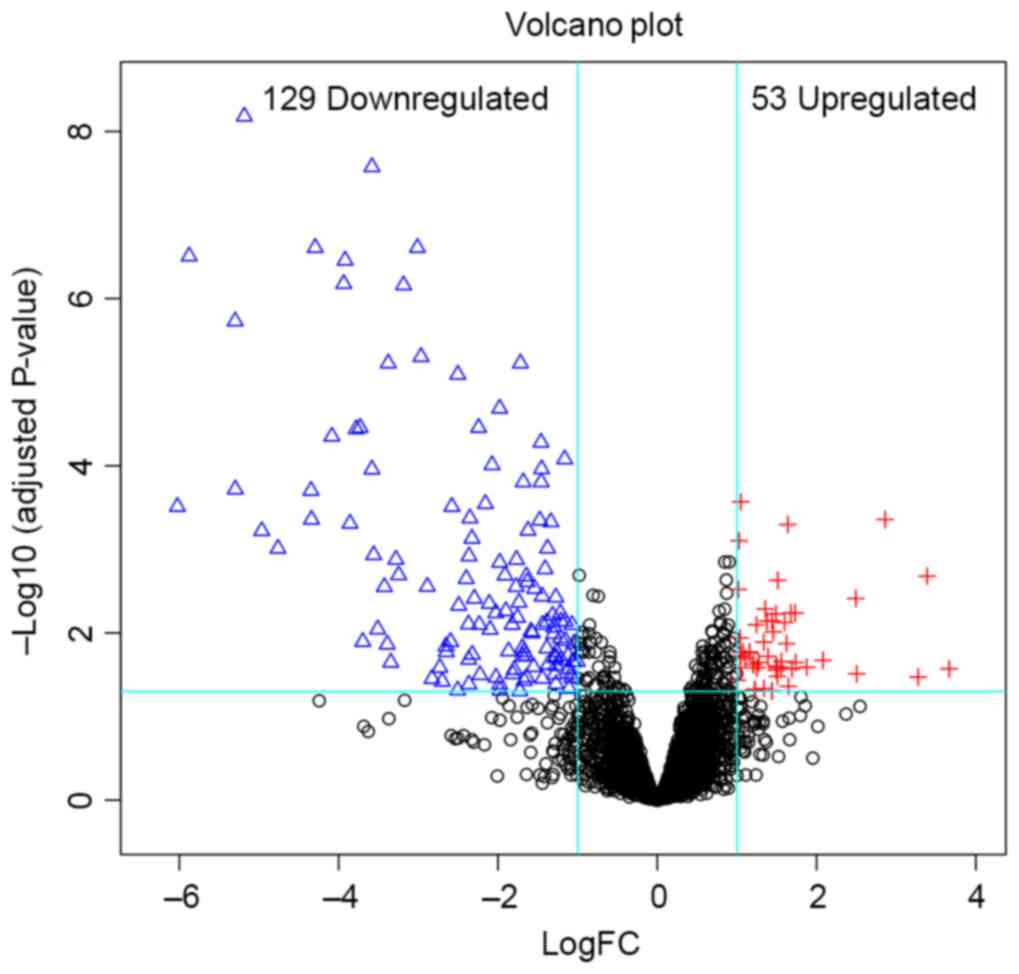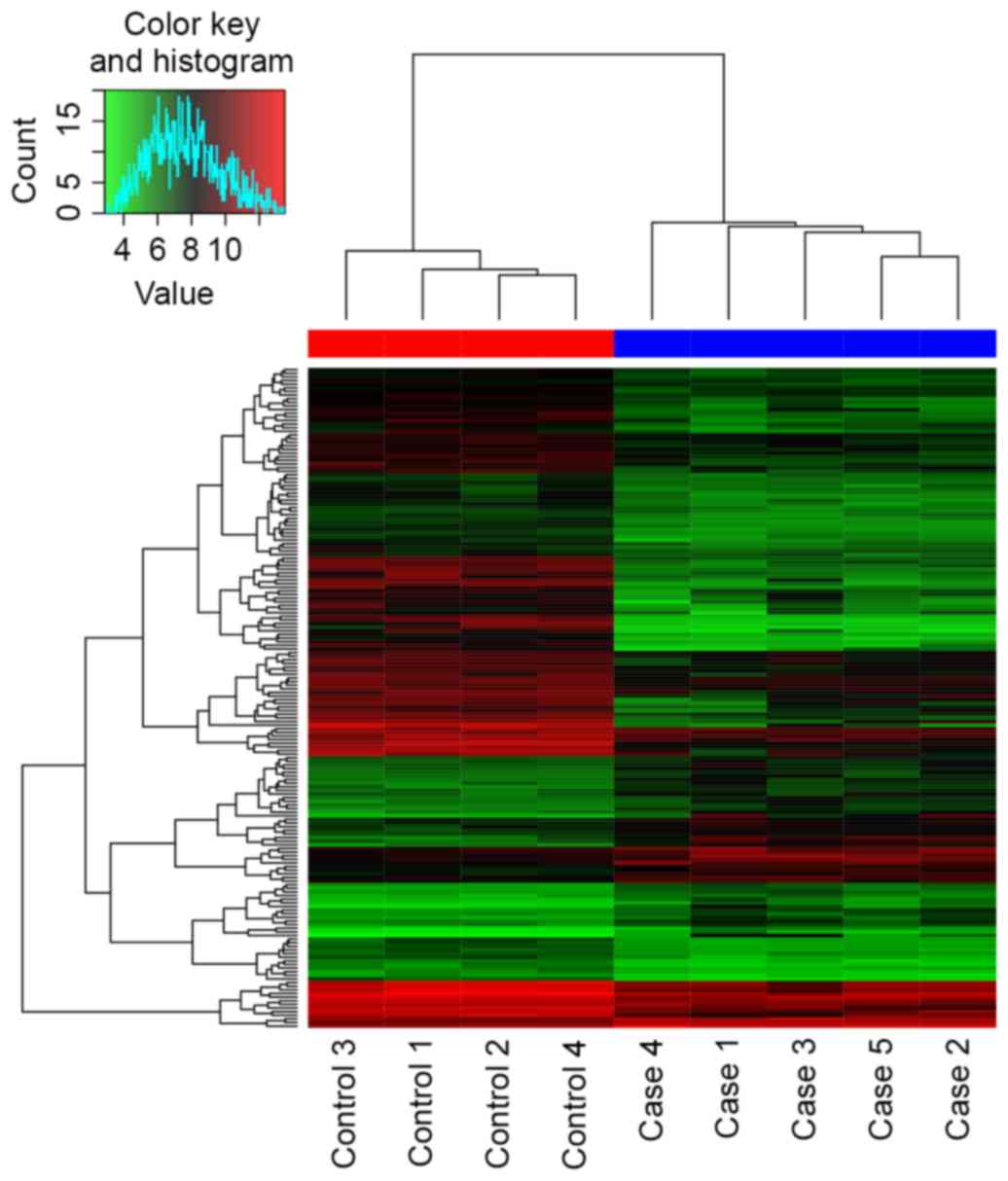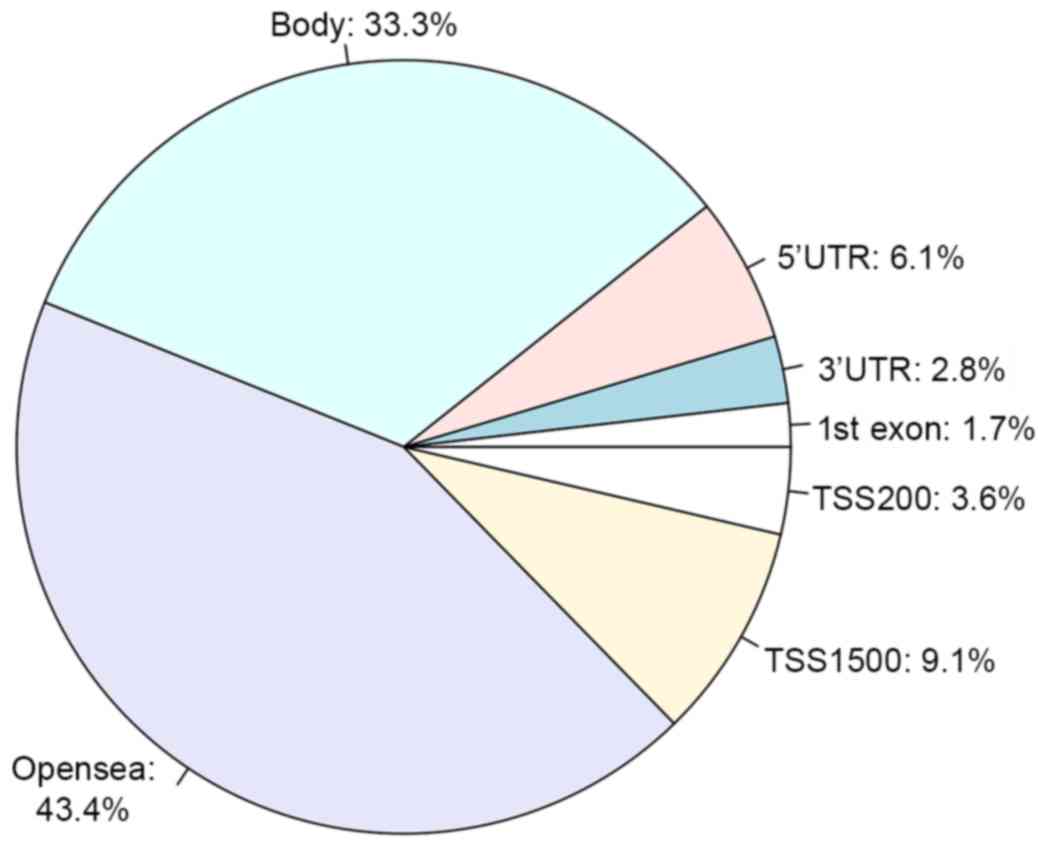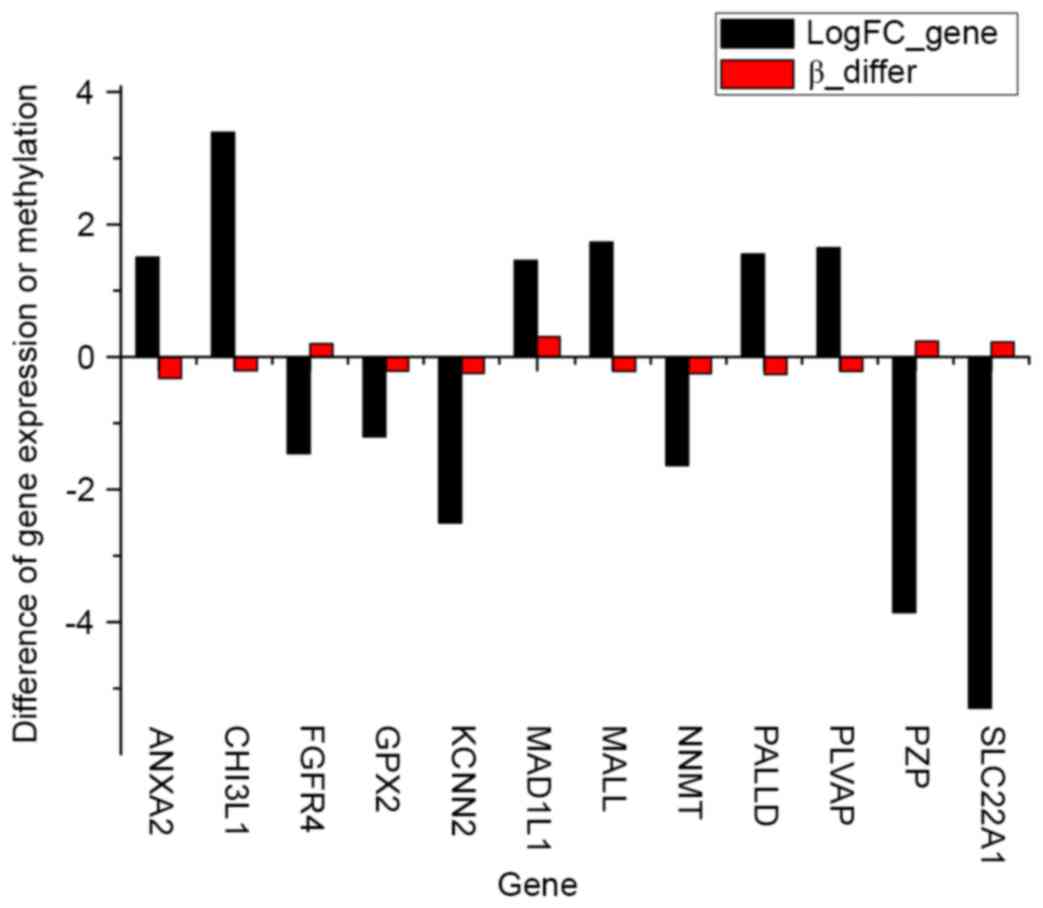Screening the key genes of hepatocellular adenoma via microarray analysis of DNA expression and methylation profiles
- Authors:
- Published online on: July 26, 2017 https://doi.org/10.3892/ol.2017.6673
- Pages: 3975-3980
-
Copyright: © Liu et al. This is an open access article distributed under the terms of Creative Commons Attribution License.
Abstract
Introduction
Hepatocellular adenoma (HCA) is a benign liver tumor that occurs mainly in young females subsequent to the long-term use of oral contraceptives (1,2). It is a type of rare tumor with low morbidity (3). However, HCA may lead to hemorrhage, and even malignant transformation to hepatocellular carcinoma (HCC), which is the third leading cause of cancer-associated mortality worldwide (4–8). A rising incidence has been reported due to improved application of diagnostic imaging techniques (9). HCA is rare in children, men and post-menopausal women. The use of androgenic steroids for Fanconi's anemia or acquired aplastic anemia is a risk factor for the development of HCA (10). Other drugs are involved in its development, such as clomiphene, barbiturates and recombinant human growth hormone (11–13). Obesity and alcohol abuse have also been reported as risk factors for developing HCA (14).
Previously, ultrasound and magnetic resonance imaging (MRI) have been suggested as effective tools for the diagnosis of HCA and explore its biological mechanisms (15). According to the different genetic mutations, HCA is divided into 4 major molecular subgroups: Hepatocellular nuclear factor-1α (HNF1α)-mutated type HCA; β-catenin-mutated type HCA; inflammatory type HCA; and unclassified type HCA (8,14,16). The transcription factor 1 (TCF1) gene, which encodes HNF1α, has been identified in the liver (16). Overexpression of certain genes, including erb-b2 receptor tyrosine kinase 2, mechanistic target of rapamycin, platelet-derived growth factor α polypeptide, platelet-derived growth factor β polypeptide and cyclin D1, has been identified in HCA, and the products of these genes are associated with cell proliferation, cell cycle activation and angiogenesis (17).
In the human genome, GC-rich DNA sequences, also known as CpG islands, are frequently enriched in the first exon and the promoter (18). DNA methylation at CpG islands located upstream of a gene promoter is associated with differential expression of the gene. DNA methylation regulates gene silencing by directly inhibiting the binding of methylation-dependent transcriptional activators or indirectly altering the affinity of proteins, including methylated DNA binding domain protein, involved in chromatin remodeling (19–23). At present, DNA methylation is widely identified in human cancer, including HCC. It was reported that long interspersed nuclear element-1 (LINE-1) has lower DNA methylation levels in hepatitis virus and aflatoxin-associated HCC compared with normal liver tissue (24,25). In addition, hypomethylation of LINE-1 was associated with advanced disease and poorer survival in HCC (26). The DNA methylation level of spermidine/spermine N1-acetyltransferase family member 2 (SAT2) also has a significant role in liver carcinogenesis. It has been suggested that decreased SAT2 methylation of white blood cell DNA was significantly associated with increased HCC risk later in life (27).
It is challenging to diagnose HCC and HCA at an early stage. Numerous therapies are limited when HCC enters the advanced stage, as the advanced stage is accompanied by severe liver dysfunction (28). Therefore, it is necessary to identify early biomarkers of HCA. In the present study, data of the DNA methylation profile and gene expression profile was extracted from the Gene Expression Omnibus (GEO) database. Certain therapeutic targets and the related pathways that may be associated with the development of HCA were identified by microarray analysis. This may contribute to promoting available biomarkers for the early diagnosis, therapy and prognosis of HCA.
Materials and methods
Microarray data
The gene expression profile and DNA methylation profile were both downloaded from the GEO (http://www.ncbi.nlm.nih.gov/geo/) database. The gene expression profile (GSE7473) contained 41 samples, including 8 HNF1α-mutated HCA and the corresponding non-tumor liver samples (each sample was assessed four times using 11K_VJF-ARRAY; GPL3282), and 5 HNF1α-mutated HCA and 4 non-related non-tumor liver samples (the 9 samples were assessed using GPL96 Affymetrix Human Genome U133A Array). In the present study, the 9 samples that were assessed via GPL96 were used as the objects, and the 5 HNF1α-mutated HCA and 4 non-related non-tumor liver samples were classified as the case and control groups, respectively. The DNA methylation profile (GSE43091), provided by Pilati et al (29), contained 50 HCA and 4 normal liver tissues. These 54 samples were achieved by GPL13534 Illumina HumanMethylation450 BeadChip (HumanMethylation450_15017482).
Data preprocessing
The raw microarray data were converted into expression data using the affy package of R. The values of multiple probes that correspond to the same gene were summarized. For original DNA methylation data, the β value of every methylated site was calculated and normalized using the IMA package of R.
Identification of differentially methylated sites and differentially expressed genes (DEGs)
DEGs were identified using the limma package of R with P<0.05 and |log2 (fold-change)|>1. A paired Student's t-test was conducted on the methylation levels between HCA samples and normal samples, and the differentially methylated sites with adjusted P<0.05 and |Δβ|>0.2 were selected.
Functional enrichment analysis of DEGs
Gene Ontology (GO) and Kyoto Encyclopedia of Genes and Genomes (KEGG) pathway analysis of DEGs was performed using the Database for Annotation, Visualization and Integrated Discovery (DAVID). DAVID was used to perform functional annotation for a list of genes, gene functional classification or gene ID conversion. All GO terms and KEGG pathways with P<0.05 that contained at least five genes were selected for subsequent analysis.
Comprehensive analysis of gene expression profile and DNA methylation profile
The genes in which differentially methylated sites were located were identified using the annotation files of the methylation chip platform.
Results
Differentially methylated sites and differentially expressed genes
In total, 182 DEGs (53 upregulated and 129 downregulated) were identified in HCA. The volcano plot (Fig. 1) showed the distribution of DEGs. From the heatmap (Fig. 2), the case samples were found to be distinguished from the control samples. Additionally, a total of 3,902 differentially methylated sites were obtained, including 3,715 downregulated methylated sites and 187 upregulated methylated sites. These methylated sites were mostly located in the intergenic and gene-coding regions of genes (Fig. 3).
Enriched GO terms and KEGG pathways
In the present study, a total of 238 enriched GO terms and 14 KEGG pathways were identified according to the criteria P<0.05. The top 20 enriched GO terms are listed in Table I. The majority of the enriched GO terms were involved in the organic acid metabolic process. The enriched KEGG pathways of the DEGs are shown in Table II. Certain KEGG pathways, for example the chemical carcinogenesis pathway, mineral absorption pathway and Bile secretion, were directly associated with HCA, and they may affect the development of HCA.
Key genes in hepatocellular adenoma
In total, 12 DEGs that contained differentially methylated sites were identified in the case groups compared with the control groups (Fig. 4). Among the DEGs, 8 genes with inverse associations between gene expression level and DNA methylation level were identified, consisting of annexin A2 (ANXA2), chitinase 3-like 1 (CHI3L1), fibroblast growth factor receptor 4 (FGFR4), mal, T-cell differentiation protein like (MALL), palladin, cytoskeletal associated protein (PALLD), plasmalemma vesicle associated protein (PLVAP), pregnancy zone protein (PZP) and solute carrier family 22 member 1 (SLC22A1).
Discussion
The development of human cancers is associated with two factors: Gradual accumulation and mutual interactions of genetic and epigenetic alterations (30). As one of the major characteristics in human cancers, epigenetic alterations may suggest the molecular mechanisms underlying malignant transformation (30–33). DNA methylation is one of these epigenetic mechanisms, and is widely found in human cancers, including HCA. At present, studies have reported that a family of DNA methyltransferase enzymes (DNMTs) mediates DNA methylation. DNMT1 was found to maintain methylation, whereas DNMT3A and DNMT3B induced de novo methylation (34). Promoter hypermethylation was associated with gene expression and resulted in transcriptional inhibition and loss of gene function. Certain studies have revealed that dysregulation of the removal and establishment of DNA methylation was involved in hepatocarcinogenesis (35,36). In HCC, hypermethylation mainly affects the expression of certain tumor suppressor genes, particularly the genes involving in cell differentiation, cell proliferation, cell adhesion, cellular metabolism, and DNA repair. Hypermethylated genes, including adenomatosis polyposis coli, Ras association domain family member 1 and suppressor of cytokine signaling 1, have been identified in chronic hepatitis and cirrhosis (20,37–40). Also, genes such as glutathione S-transferase pi 1, cyclin dependent kinase inhibitor 2A, cytochrome c oxidase subunit II, HIC ZBTB transcriptional repressor 1, and runt related transcription factor 3, which were frequently methylated, have been identified in dysplastic liver nodules (20,41–43).
Previously, the emergence of new diagnostic methods such as ultrasound, and novel treatment methods such as liver-directed therapy, has improved the prognosis of HCA (44,45). However, a limit remains in terms of its early diagnosis and curative potential. The present study used microarray technology to identify key factors, such as the genes, biological process and signal pathways, involved in HCA.
In the present study, DNA expression and methylation profiles were obtained by bioinformatics to identify the differentially methylated sites and DEGs in HCA compared with normal liver tissues. A total of 182 DEGs (53 upregulated and 129 downregulated) and 3,902 differentially methylated sites (187 upregulated and 3,715 downregulated) were identified. In addition, 8 overlapped genes with inverse correlations between methylation levels and gene expression levels were identified, including PZP and SLC22A1.
Important genes may be potential targets for HCA diagnosis or treatment. PZP is a major pregnancy-associated plasma protein that is strongly associated with α 2-macroglobulin (46). PZP is considered an auxiliary index for the identification of gynecological tumors. Berne (47) revealed that estrogen induced PZP expression, and PZP was found in the serum of women who usually took oral contraceptives containing estrogen. As the long-term use of oral contraceptives may lead to HCA, this indicates that PZP may be a major gene in HCA. Polyspecific organic cation transporters are involved in the uptake of positively charged and neutral small molecules, certain drugs and environmental toxins into organs including the liver, kidney and intestine (48). In 1967, the human organic cation transporter 1, which is encoded by SLC22A1, was first reported to remove >70% of the serotonin in the portal blood via filtration and metabolism in the liver (49). Solute carrier family 22 (organic cation transporter), member 1 is the major active influx protein responsible for the transport of imatinib mesylate into cells (50). The present study hypothesized that SLC22A1 may play a critical role in removing endogenous substances, drugs and other toxins associated with HCA.
According to the functional enrichment of DEG analysis, certain GO terms associated with metabolic process and response to drugs were identified, and the KEGG pathways closely associated with chemical carcinogenesis and mineral absorption were obtained. Chemical carcinogenesis has become synonymous with genotoxic events, which lead to DNA damage and genetic mutations (51). In addition, epigenetic effects, such as aberrant DNA methylation, have been identified as one of the key contributors to carcinogenesis. Aberrant DNA methylation has been widely studied in carcinogenesis (19,52,53). Although certain animal models, which reflect the association between exposure to chemical carcinogens and epigenetic effects, have been established, the specific mechanism of this process has yet to be clarified (54).
Overall, using bioinformatics analysis, DEGs, differentially methylated sites, significant GO terms and KEGG pathways were obtained. It was found that DEGs were mainly involved in acid metabolic processing and chemical carcinogenesis in HCA. Based on comprehensive bioinformatics analysis, 8 important DEGs, consisting of SLC22A1, PZP, ANXA2, CHI3L1, FGFR4, MALL, PALLD and PLVAP, were identified. These DEGs, which are related to HCA, may potentially act as biomarkers for detection, prognosis, monitoring and predicting therapeutic responses in HCA. However, additional experiments are required to confirm their function in HCA.
References
|
Nault JC, Bioulac-Sage P and Zucman-Rossi J: Hepatocellular benign tumors-from molecular classification to personalized clinical care. Gastroenterology. 144:888–902. 2013. View Article : Google Scholar : PubMed/NCBI | |
|
Bioulac-Sage P, Balabaud C and Zucman-Rossi J: Focal nodular hyperplasia, hepatocellular adenomas: Past, present, future. Gastroenterol Clin Biol. 34:355–358. 2010. View Article : Google Scholar : PubMed/NCBI | |
|
van Aalten SM, Witjes CD, de Man RA, Ijzermans JN and Terkivatan T: Can a decision-making model be justified in the management of hepatocellular adenoma? Liver Int. 32:28–37. 2012. View Article : Google Scholar : PubMed/NCBI | |
|
Choi BY and Nguyen MH: The diagnosis and management of benign hepatic tumors. J Clin Gastroenterol. 39:401–412. 2005. View Article : Google Scholar : PubMed/NCBI | |
|
Buell JF, Tranchart H, Cannon R and Dagher I: Management of benign hepatic tumors. Surg Clin North Am. 90:719–735. 2010. View Article : Google Scholar : PubMed/NCBI | |
|
Bioulac-Sage P, Laumonier H, Couchy G, Le Bail B, Sa Cunha A, Rullier A, Laurent C, Blanc JF, Cubel G, Trillaud H, et al: Hepatocellular adenoma management and phenotypic classification: The Bordeaux experience. Hepatology. 50:481–489. 2009. View Article : Google Scholar : PubMed/NCBI | |
|
Micchelli ST, Vivekanandan P, Boitnott JK, Pawlik TM, Choti MA and Torbenson M: Malignant transformation of hepatic adenomas. Mod Pathol. 21:491–497. 2008. View Article : Google Scholar : PubMed/NCBI | |
|
Zucman-Rossi J, Jeannot E, Nhieu JT, Scoazec JY, Guettier C, Rebouissou S, Bacq Y, Leteurtre E, Paradis V, Michalak S, et al: Genotype-phenotype correlation in hepatocellular adenoma: New classification and relationship with HCC. Hepatology. 43:515–524. 2006. View Article : Google Scholar : PubMed/NCBI | |
|
Shanbhogue A, Shah SN, Zaheer A, Prasad SR, Takahashi N and Vikram R: Hepatocellular adenomas: Current update on genetics, taxonomy, and management. J Comput Assist Tomogr. 35:159–166. 2011. View Article : Google Scholar : PubMed/NCBI | |
|
Velazquez I and Alter BP: Androgens and liver tumors: Fanconi's anemia and non-Fanconi's conditions. Am J Hematol. 77:257–267. 2004. View Article : Google Scholar : PubMed/NCBI | |
|
Carrasco D, Barrachina M, Prieto M and Berenguer J: Clomiphene citrate and liver-cell adenoma. N Engl J Med. 310:1120–1121. 1984. View Article : Google Scholar : PubMed/NCBI | |
|
Vazquez JJ and Marigil MA: Liver-cell adenoma in an epileptic man on barbiturates. Histol Histopathol. 4:301–303. 1989.PubMed/NCBI | |
|
Espat J, Chamberlain RS, Sklar C and Blumgart LH: Hepatic adenoma associated with recombinant human growth hormone therapy in a patient with Turner's syndrome. Dig Surg. 17:640–643. 2000. View Article : Google Scholar : PubMed/NCBI | |
|
Bioulac-Sage P, Rebouissou S, Thomas C, Blanc JF, Saric J, Sa Cunha A, Rullier A, Cubel G, Couchy G, Imbeaud S, et al: Hepatocellular adenoma subtype classification using molecular markers and immunohistochemistry. Hepatology. 46:740–748. 2007. View Article : Google Scholar : PubMed/NCBI | |
|
Manichon AF, Bancel B, Durieux-Millon M, Ducerf C, Mabrut JY, Lepogam MA and Rode A: Hepatocellular adenoma: Evaluation with contrast-enhanced ultrasound and MRI and correlation with pathologic and phenotypic classification in 26 lesions. HPB Surg. 2012:4187452012. View Article : Google Scholar : PubMed/NCBI | |
|
Bluteau O, Jeannot E, Bioulac-Sage P, Marqués JM, Blanc JF, Bui H, Beaudoin JC, Franco D, Balabaud C, Laurent-Puig P and Zucman-Rossi J: Bi-allelic inactivation of TCF1 in hepatic adenomas. Nat Genet. 32:312–315. 2002. View Article : Google Scholar : PubMed/NCBI | |
|
Pelletier L, Rebouissou S, Paris A, Rathahao-Paris E, Perdu E, Bioulac-Sage P, Imbeaud S and Zucman-Rossi J: Loss of hepatocyte nuclear factor 1alpha function in human hepatocellular adenomas leads to aberrant activation of signaling pathways involved in tumorigenesis. Hepatology. 51:557–566. 2010. View Article : Google Scholar : PubMed/NCBI | |
|
Antequera F and Bird A: Number of CpG islands and genes in human and mouse. Proc Natl Acad Sci USA. 90:11995–11999. 1993. View Article : Google Scholar : PubMed/NCBI | |
|
Baylin SB and Jones PA: A decade of exploring the cancer epigenome-biological and translational implications. Nat Rev Cancer. 11:726–734. 2011. View Article : Google Scholar : PubMed/NCBI | |
|
Um TH, Kim H, Oh BK, Kim MS, Kim KS, Jung G and Park YN: Aberrant CpG island hypermethylation in dysplastic nodules and early HCC of hepatitis B virus-related human multistep hepatocarcinogenesis. J Hepatol. 54:939–947. 2011. View Article : Google Scholar : PubMed/NCBI | |
|
Pogribny IP and Rusyn I: Role of epigenetic aberrations in the development and progression of human hepatocellular carcinoma. Cancer Lett. 342:223–230. 2014. View Article : Google Scholar : PubMed/NCBI | |
|
Suzuki MM and Bird A: DNA methylation landscapes: Provocative insights from epigenomics. Nat Rev Genet. 9:465–476. 2008. View Article : Google Scholar : PubMed/NCBI | |
|
Fuks F, Hurd PJ, Wolf D, Nan X, Bird AP and Kouzarides T: The methyl-CpG-binding protein MeCP2 links DNA methylation to histone methylation. J Biol Chem. 278:4035–4040. 2003. View Article : Google Scholar : PubMed/NCBI | |
|
Kim BH, Cho NY, Shin SH, Kwon HJ, Jang JJ and Kang GH: CpG island hypermethylation and repetitive DNA hypomethylation in premalignant lesion of extrahepatic cholangiocarcinoma. Virchows Arch. 455:343–351. 2009. View Article : Google Scholar : PubMed/NCBI | |
|
Zhang YJ, Wu HC, Yazici H, Yu MW, Lee PH and Santella RM: Global hypomethylation in hepatocellular carcinoma and its relationship to aflatoxin B(1) exposure. World J Hepatol. 4:169–175. 2012. View Article : Google Scholar PubMed/NCBI | |
|
Tangkijvanich P, Hourpai N, Rattanatanyong P, Wisedopas N, Mahachai V and Mutirangura A: Serum LINE-1 hypomethylation as a potential prognostic marker for hepatocellular carcinoma. Clin Chim Acta. 379:127–133. 2007. View Article : Google Scholar : PubMed/NCBI | |
|
Wu HC, Wang Q, Yang HI, Tsai WY, Chen CJ and Santella RM: Global DNA methylation levels in white blood cells as a biomarker for hepatocellular carcinoma risk: A nested case-control study. Carcinogenesis. 33:1340–1345. 2012. View Article : Google Scholar : PubMed/NCBI | |
|
Graziadei I, Finkenstedt A, Stauber RE, Müller C, Trauner M and Vogel W: 78 Imatinib treatment for patients with advanced stage hepatocellular carcinoma: A multicenter phase II trial. Gastroenterology. 138:(Suppl 1). S775–S776. 2010. View Article : Google Scholar | |
|
Pilati C, Letouzé E, Nault JC, Imbeaud S, Boulai A, Calderaro J, Poussin K, Franconi A, Couchy G, Morcrette G, et al: Genomic profiling of hepatocellular adenomas reveals recurrent FRK-activating mutations and the mechanisms of malignant transformation. Cancer Cell. 25:428–441. 2014. View Article : Google Scholar : PubMed/NCBI | |
|
You JS and Jones PA: Cancer genetics and epigenetics: Two sides of the same coin? Cancer cell. 22:9–20. 2012. View Article : Google Scholar : PubMed/NCBI | |
|
Anwar SL and Lehmann U: DNA methylation, microRNAs, and their crosstalk as potential biomarkers in hepatocellular carcinoma. World J Gastroenterol. 20:7894–7913. 2014. View Article : Google Scholar : PubMed/NCBI | |
|
Knudson AG: Cancer genetics. Am J Med Genet. 111:96–102. 2002. View Article : Google Scholar : PubMed/NCBI | |
|
Rodriguez-Paredes M and Esteller M: Cancer epigenetics reaches mainstream oncology. Nat Med. 17:330–339. 2011. View Article : Google Scholar : PubMed/NCBI | |
|
Cedar H and Bergman Y: Programming of DNA methylation patterns. Annu Rev Biochem. 81:97–117. 2012. View Article : Google Scholar : PubMed/NCBI | |
|
Lee HS, Kim BH, Cho NY, Yoo EJ, Choi M, Shin SH, Jang JJ, Suh KS, Kim YS and Kang GH: Prognostic implications of and relationship between CpG island hypermethylation and repetitive DNA hypomethylation in hepatocellular carcinoma. Clin Cancer Res. 15:812–820. 2009. View Article : Google Scholar : PubMed/NCBI | |
|
Park HJ, Yu E and Shim YH: DNA methyltransferase expression and DNA hypermethylation in human hepatocellular carcinoma. Cancer Lett. 233:271–278. 2006. View Article : Google Scholar : PubMed/NCBI | |
|
Csepregi A, Röcken C, Hoffmann J, Gu P, Saliger S, Müller O, Schneider-Stock R, Kutzner N, Roessner A, Malfertheiner P and Ebert MP: APC promoter methylation and protein expression in hepatocellular carcinoma. J Cancer Res Clin Oncol. 134:579–589. 2008. View Article : Google Scholar : PubMed/NCBI | |
|
Lehmann U, Berg-Ribbe I, Wingen LU, Brakensiek K, Becker T, Klempnauer J, Schlegelberger B, Kreipe H and Flemming P: Distinct methylation patterns of benign and malignant liver tumors revealed by quantitative methylation profiling. Clin Cancer Res. 11:3654–3660. 2005. View Article : Google Scholar : PubMed/NCBI | |
|
Hua D, Hu Y, Wu YY, Cheng ZH, Yu J, Du X and Huang ZH: Quantitative methylation analysis of multiple genes using methylation-sensitive restriction enzyme-based quantitative PCR for the detection of hepatocellular carcinoma. Exp Mol Pathol. 91:455–460. 2011. View Article : Google Scholar : PubMed/NCBI | |
|
Wang L, Wang WL, Zhang Y, Guo SP, Zhang J and Li QL: Epigenetic and genetic alterations of PTEN in hepatocellular carcinoma. Hepatol Res. 37:389–396. 2007. View Article : Google Scholar : PubMed/NCBI | |
|
Lee S, Lee HJ, Kim JH, Lee HS, Jang JJ and Kang GH: Aberrant CpG island hypermethylation along multistep hepatocarcinogenesis. Am J Pathol. 163:1371–1378. 2003. View Article : Google Scholar : PubMed/NCBI | |
|
Nishida N, Kudo M, Nagasaka T, Ikai I and Goel A: Characteristic patterns of altered DNA methylation predict emergence of human hepatocellular carcinoma. Hepatology. 56:994–1003. 2012. View Article : Google Scholar : PubMed/NCBI | |
|
Shim YH, Yoon GS, Choi HJ, Chung YH and Yu E: p16 Hypermethylation in the early stage of hepatitis B virus-associated hepatocarcinogenesis. Cancer Lett. 190:213–219. 2003. View Article : Google Scholar : PubMed/NCBI | |
|
Boas FE, Do B, Louie JD, Kothary N, Hwang GL, Kuo WT, Hovsepian DM, Kantrowitz M and Sze DY: Optimal imaging surveillance schedules after liver-directed therapy for hepatocellular carcinoma. J Vasc Interv Radiol. 26:69–73. 2015. View Article : Google Scholar : PubMed/NCBI | |
|
Kong WT, Wang WP, Huang BJ, Ding H, Mao F and Si Q: Contrast-enhanced ultrasound in combination with color doppler ultrasound can improve the diagnostic performance of focal nodular hyperplasia and hepatocellular adenoma. Ultrasound Med Biol. 41:944–951. 2015. View Article : Google Scholar : PubMed/NCBI | |
|
Christensen U, Simonsen M, Harrit N and Sottrup-Jensen L: Pregnancy zone protein, a proteinase-binding macroglobulin. Interactions with proteinases and methylamine. Biochemistry. 28:9324–9331. 1989. View Article : Google Scholar : PubMed/NCBI | |
|
Berne BH: Alpha-2 pregnoglobulin (pregnancy zone protein)-An estrogen-dependent macroglobulin elevated in pregnancy and oral contraception. Clin Chem. 19:6571973. | |
|
Boxberger KH, Hagenbuch B and Lampe JN: Common drugs inhibit human organic cation transporter 1 (OCT1)-mediated neurotransmitter uptake. Drug Metab Dispos. 42:990–995. 2014. View Article : Google Scholar : PubMed/NCBI | |
|
Thomas DP and Vane JR: 5-hydroxytryptamine in the circulation of the dog. Nature. 216:335–338. 1967. View Article : Google Scholar : PubMed/NCBI | |
|
Cao C, Li X, Liu T, Zhang L, Shen K and Zhu H: Human organic cation transporter 1 protein levels of granulocytes can optimize imatinib therapy in patients with chronic myeloid leukemia. Acta Haematol. 133:199–204. 2015. View Article : Google Scholar : PubMed/NCBI | |
|
Loeb LA and Harris CC: Advances in chemical carcinogenesis: A historical review and prospective. Cancer Res. 68:6863–6872. 2008. View Article : Google Scholar : PubMed/NCBI | |
|
Fraga MF, Herranz M, Espada J, Ballestar E, Paz MF, Ropero S, Erkek E, Bozdogan O, Peinado H, Niveleau A, et al: A mouse skin multistage carcinogenesis model reflects the aberrant DNA methylation patterns of human tumors. Cancer Res. 64:5527–5534. 2004. View Article : Google Scholar : PubMed/NCBI | |
|
Yamamoto E, Yamano HO, Suzuki H, Kamimae S, Imai K, Shinomura Y and Toyota M: The role of aberrant DNA methylation in carcinogenesis of colorectal tumor with K-ras mutation. Japan J Mol Tumor Marker Res. 25:37–38. 2010.(In Japanese). | |
|
Pogribny IP and Rusyn I: Environmental toxicants, epigenetics, and cancer. Adv Exp Med Biol. 754:215–232. 2013. View Article : Google Scholar : PubMed/NCBI |













